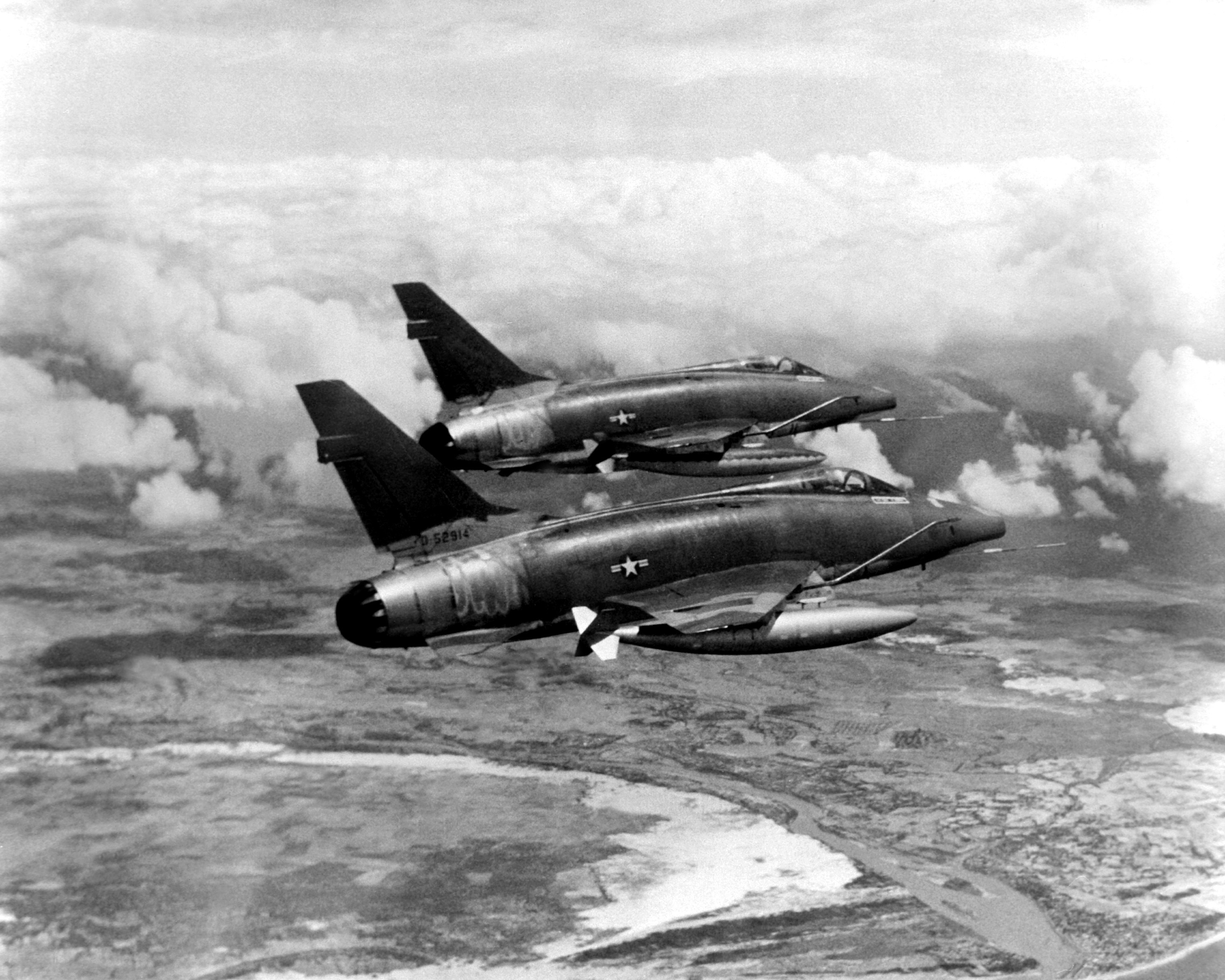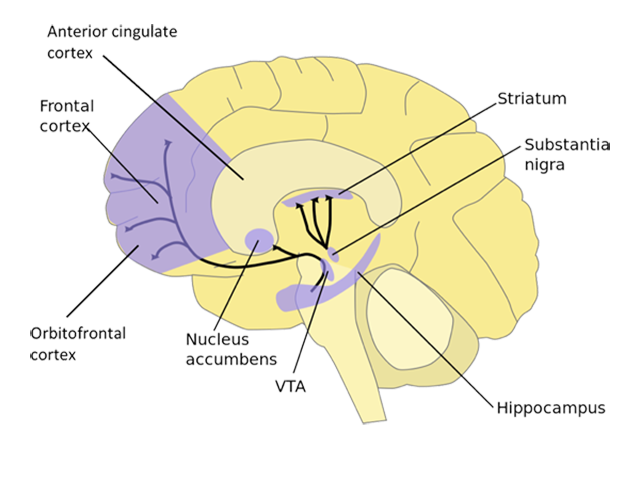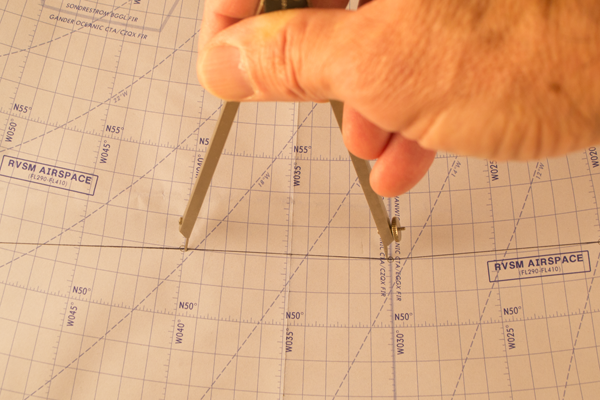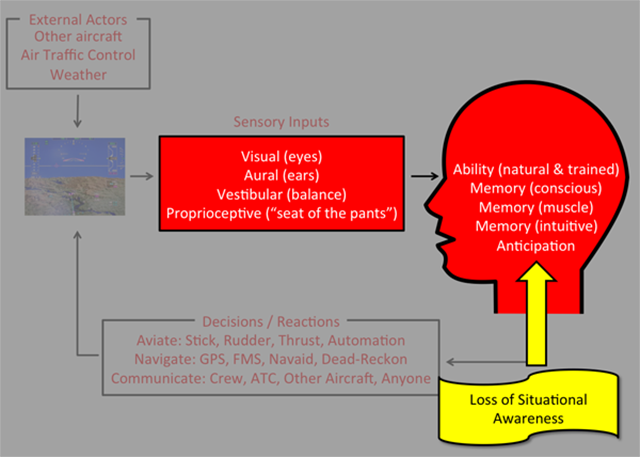On its surface, the idea of having an awareness of your situation would seem to be as natural as the act of flying itself. That is to say, it isn't natural at all.
— James Albright

Updated:
2016-01-24
On its surface, the idea of having an awareness of your situation would seem to be as natural as the act of flying itself. That is to say, it isn't natural at all. If you endeavor to collect all the relevant information about your environment, accurately interpret that information, act on it, and recheck the data to see if it adjusts according to your actions; well, you will have good SA. But it certainly isn't something you will be able to master your first day on the job. Good SA is a learned skill. So let's get started.
2 — A pilot's situational awareness model
3 — Situational awareness loss detection

1
Historical basis
Part of the reason any discussion of situational awareness can become a bit confusing is that there is so much garbage out there. The United States Air Force is to blame for some of this, I fear. What started as a pilot survival technique has burgeoned into an occupation for academia eager for a government paycheck. (Much of it was written by the Chief Scientist of the Air Force. Doesn't that title tell you all you need to know?) Nevertheless, it might be useful to look at some of this just to get an idea of what a pilot's view of situational awareness is not. (If you want to skip this, I don't blame you. Now that I've written it, I wish I had skipped it.)
The Titanic
"When anyone asks how I can best describe my experience in nearly 40 years at sea, I merely say, uneventful. Of course there have been winter gales, and storms and fog the like, but in all my experience, I have never been in any accident of any sort worth speaking about. . . . I never saw a wreck and never have been wrecked, nor was I ever in any predicament that threatened to end in disaster of any sort. I cannot imagine any condition which would cause a ship to founder. I cannot conceive of any vital disaster happening to this vessel. Modern ship building has gone beyond that."
Captain Edward Smith quoted in 1907.
He was the Captain of Titanic when it sunk in 1912.
From: CRM Leadership & Followership 2.0, Antonio Cortés
The United States Air Force (pilots)
From the day the military started flying more than one airplane in close proximity to another against an enemy doing the same, it became obvious that unless we knew what we were doing, we could end up hitting each other. Fighter pilots practiced varying levels of situational awareness, starting at "1 v 1." When it became obvious having a wingman comes in handy there was "2 v 2" and things progressed from there until you had the proverbial "fur ball."
Even flying "1" with no "v" at all we figured out that having the pilot with his or her head on a swivel kept things safe. As the skies got more crowded and the airplanes got faster, we developed talk about situational awareness and the need to have a 3-D picture of your part of the world in your head at all times. I had a pretty good understanding of SA from a pilot's perspective in the US of AF starting in 1979 and things only got better as more and more pilots understood the importance of good SA. Here's my story from 1984: B-707 Engine Failure at V1.
But then something terrible happened . . .
The United States Air Force (non-pilots)
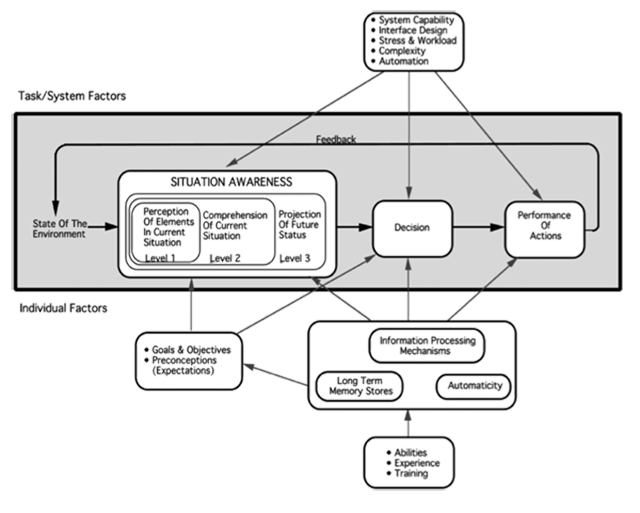
Model of SA in dynamic decision making, from Endsley, figure 1.
. . . in the early 1990's the pseudo sciences got involved and turned a straightforward concept into graphs, tables, and charts like the one shown here. A lot of good has come from the human factors world that we can see daily in our cockpits in the form of greatly improved avionics. The problem comes when these academics get involved with flight procedures. No matter, we will try to extract some good from this.
The [1995 model of SA] consists of several key factors: perception, comprehension, and projection as three levels of SA.
Source: Endsley, pg. 5.
All straight forward except the word "projection." There is scientific evidence that parts of the brain's cortex include the ability to anticipate, so that's what we'll use in place of projection.
- the role of goals and goal-directed processing in directing attention and interpreting the significance of perceived information;
- the simultaneous role of information salience in "grabbing" attention in a data-driven fashion;
- the importance of alternating goal-driven and data-driven processing in processing information in the environment;
- the role of expectations (fed by the current model of the situation and by long-term memory stores) in directing attention and interpreting information;
- the heavy demands on limited working memory restricting SA for novices and for those in novel situations, but the tremendous advantages of mental models and pattern matching to prototypical schema that largely circumvent these limits;
Source: Endsley, pg. 5.
For "working memory" we can think of our conscious memory.
- the use of mental models for directing attention to relevant information, providing a means for integrating different bits of information and comprehending its meaning (as relevant to current goals), and allowing people to make useful projections of likely future events and states;
- the use of Q-morphisms in mental models to provide defaults, providing reasonable SA with even limited and missing information, and a context model providing for the representation of uncertainty in the situation representation;
- a process for building and updating mental models over time;
- pattern matching to schema, prototypical states of the mental model, that provide rapid retrieval of comprehension and projection for the recognized situation through critical cues and, in many cases, providing single-step retrieval of appropriate actions for the situation;
Source: Endsley, pg. 5.
There is scientific evidence that our brains can store and retrieve information behind the scenes of our conscious thought in a way that can be useful. I would call this intuitive thought.
More about this: Decision Making.
the role of automaticity on SA;
Source: Endsley, pg. 5.
Let's call this muscle memory and be done with it.
- people as active participants in the development of their own SA, based on how they direct their attention, communicate with team mates, and manipulate their tools to search for desired information;
- an ongoing dynamic process of gathering and interpreting information to update the situation model and using that situation model to search for information until decisions can be made;
- a linkage between goals and mental models that drives the development or selection of plans and scripts for directing actions, the use of the activated mental model to direct attention to the environment to feed into the constantly updated situation model, and use of the situation model in updating the selection of the mental model to be active;
- the role of environmental, task, and system factors in SA, including the capability of systems for deriving needed information; the effect of system complexity on SA; the effectiveness of the user interface for providing rapid access and understandability of needed information; the role of stressors, workload, and fatigue on SA mechanisms and processes; and the effect of automation on SA; and
- an error taxonomy, based on this model, that characterizes the underlying factors that can lead to SA errors in perception, comprehension and projection.
Source: Endsley, pg. 5.
The classic modern view
Situation Awareness Behavioral Markers
- Demonstrating and expressing situation awareness (e.g., the "model" of what is happening is shared within the crew).
- Active monitoring of all instruments and communications and sharing relevant information with the rest of the crew.
- Monitoring weather and traffic and sharing relevant information with the rest of the crew.
- Avoiding "tunnel vision" caused by stress (e.g., stating or asking for the "big picture").
- Being aware of factors such as stress that can degrade vigilance, and watching for performance degradation in other crewmembers.
- Staying "ahead of the curve" in preparing for planned situations or contingencies, so that situation awareness and adherence to SOPs is assured.
- Ensuring that cockpit and cabin crewmembers are aware of plans.
- Including all appropriate crewmembers in the planning process.
- Allowing enough time before maneuvers for programming of the flight management computer.
- Ensuring that all crewmembers are aware of initial entries and changed entries in the flight management system.
Source: Advisory Circular 120-51E, Appendix 1, ¶3.a.
The main components of situational awareness are:
- Environmental Awareness: Awareness of other aircraft, communications between ATC and other aircraft, weather or terrain
- Mode Awareness: Awareness of aircraft configuration and auto flight system modes. The latter includes such aspects as current and target speed, altitude, heading, AP / FD armed / engaged modes and the state of flight management system (FMS) data entries and flight planning functions
- Spatial Orientation: Awareness of geographical position and aircraft attitude
- System Awareness: Awareness of status of aircraft systems
- Time Horizon: Awareness of time management (e.g., fuel status / monitoring, time factor in smoke situation or emergency electrical configuration).
Source: Airbus Flight Operations Note, pg. 1
Of all the sources out there, Airbus seems to do the best job of cutting through the theory and producing something a pilot can use. It still suffers, I think, from confusing awareness of airplane controls (systems and automations) with the environment. They are not your environment, they are tools available to you to control your situation in the environment. That leads me to . . .
2
A pilot's situational awareness model
I don't think I've ever seen a Venn diagram or flow chart that really explains what a pilot needs to know about situational awareness. In a testimony to what one can do with a computerized box of crayons, here is my attempt.
The environment
The easiest way to think about the environment is that you are part of an airplane and that everything that surrounds that airplane is the environment. The environment includes the air around you, extraterrestrial space above you, the ground and water below you, and all the other obstacles you wish to avoid. Weather and other aircraft can certainly affect your environment as can the puppeteers pulling the strings from behind the curtain: air traffic control. Your task as a pilot is to manipulate your aircraft through the environment without hurting yourself, the airplane, or anyone else.
Situational awareness: sensory inputs
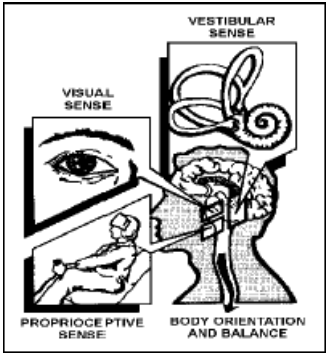
The Three Equilibrium Systems, from U.S. Army Aeromedical Training Manual, Figure 9-1.
A pilot's situational awareness requires an accurate perception of the environment and the aircraft. If you want to improve your situational awareness, you need to ensure the channels of communications from your sensory inputs are unimpeded:
- Visual. You visually acquire aircraft attitude, performance, navigation, and spatial information. You can improve all of these using technology, such as enhanced vision systems, heads up displays, radar, synthetic vision, and flight management systems.
- Aural. Of course you use your ears to listen to the radio, but the noise level of the cockpit can tell you volumes about airspeed, altitude, thrust settings, and aircraft health.
- Vestibular. Another good thing your ears do for you is a sense of balance from the vestibular system. Your ears' semicircular canals derive attitude and rate of turn information. Of course much of this is often wrong, but that fact in itself tells you something too.
- Proprioceptive. The proprioceptive system reacts to the sensations resulting from pressures on joints, muscles, and skin and from slight changes in the position of internal organs. It is closely associated with the vestibular system and, to a lesser degree, the visual system. Forces act upon the seated pilot in flight. With training and experience, the pilot can easily distinguish the most distinct movements of the aircraft by the pressures of the aircraft seat against the body. The recognition of these movements has led to the term "seat-of-the-pants" flying.
More about this: Spatial Disorientation.
Situational awareness: mental physiology
Not all of your inputs will be valid, it is up to the gray matter in your head to sort the wheat from the chaff:
- Ability. You have ability, natural and trained, to process all those sensory inputs and to make that information useful. Practice certainly helps. But you also gain ability from careful study.
- Memory. There are three types of memory and you should be aware of how you draw upon all three. Your conscious memory you know about, obviously, and it is up to you to train that memory with the correct information. Your muscle memory comes from practice. Believe it or not, you can train your subconscious memory.
- Anticipation. Your brain also anticipates based on past experiences and this can fool your conscious into thinking the inputs are different than what they are. If you test a system over and over again and get a green light, for example, there is a tendency to see a green light even if it is red.
More about this: Decision Making.
Decisions / reactions: aviate
You must always devote at least one pilot to flying the airplane and when situational awareness begins to break down, it is usually wise to dedicate that pilot to the task of keeping the airspeed, altitude, and heading where they need to be. A few thoughts:
- If the status of the airplane's viability as an air machine is in doubt, a pilot should be dedicated to the task of keeping the machine airworthy. Make an announcement of that fact with the clear understanding that this pilot will concentrate exclusively on this task. "I will fly the airplane, you sort everything else out." There are two reasons for doing this. First, you should not multi task when the airplane's flyability is in doubt. Second, if part of your brain is taken by stick and rudder chores, the decisions made by the rest of the brain will be degraded.
- Automation can be a life saver: it can automatically ensure there is sufficient power, that the airplane is pointed in the right direction, and that you have enough airspeed. But automation can also be the cause of what ails you. It is up to you to decide. To that end, the flying pilot must get back to basics and assess the situation. Is the automation keeping the airplane in steady, coordinated flight? Airspeed and altitude stable? If not, make adjustments to the automation and if that fails, cancel automation modes as necessary. Let the other pilot know what is going on. "Good autothrottles but the autopilot is confused. I am hand-flying the airplane, we are stable."
- When the chips are down, it is often best to give the lesser experienced pilot the airplane and have the other pilot do everything else, including giving the flying pilots "big picture" instructions.
Decisions / reactions: navigate
The navigation imperative can be as simple as "get us out of this valley" to as complicated as "where in the heck are we?" Fortunately this problem has gotten easier over the years.
- The amount of faith you put on the GPS is inversely proportional to the accuracy required. If you are in the middle of the ocean having a GPS position is great. In the middle of a narrow valley, it depends on your system. Remember also that a GPS can give you an altitude readout to verify or discount a suspect altimeter.
- An FMS can be the least accurate navigation tool on the flight deck, depending on its health and the status of its inputs. Aircraft systems knowledge is key here.
- If you are down to using ground-based navigational aids, be wary of readings outside an instrument's service volume and especially careful with non-directional beacons, which can be worse than non-directional!
Don't know how to dead-reckon? You probably should have a good foundation in all that appears here: Plotting.
Decisions / reactions: communicate
Crew communications. When the stress level goes up we have a tendency to latch onto the first solution that comes to mind and start to tune out alternate ideas. An especially willful captain with a good reputation can unknowingly shut off other crewmembers with better ideas, without them even realizing what has happened. A few techniques.
- State the nature of the problem and entertain ideas. Do not immediately critique ideas that are obviously wrong, they could stimulate ideas that are obviously right.
- Formulate a plan and articulate it. Do not end your discussion with "do you agree?" Instead, try "what am I not thinking about?"
- If "group think" has taken over, try to stimulate alternatives. "Has anyone heard of this happening before? What did that crew try?"
- Remember you have resources outside the airplane too. "Can we phone a friend?"
ATC communications. The people on the other side of the radio can be very helpful when it comes to figuring out items of navigation ("Where am I?") and communication ("Who should I be talking to now?") but be careful when asking about aviating questions. Many air traffic controllers are private pilots who think they understand high performance aviation but may not. The pilots on AeroPeru 603 lacked enough air sense on their own, for example, but ATC only fed to that deficit. Their Boeing 757 was experiencing classic blocked static port symptoms and when the air traffic controller reported their transponder read out agreed with what the pilots saw in the cockpit, all concerned believed the altimeters were working. Of course everyone on the airplane died but the controller lives on.
Other aircraft communications. There is a brotherhood of aviators out there and that is especially evident when one of our brethren are in trouble. You will see this flying oceanic or in remote areas. The universal pilot interplane frequency in most of the world is 123.45. Keep a listening watch when oceanic or remote, perhaps you can come to the rescue of a fellow aviator.
Communications with anyone else.
- If you don't have a satellite phone, you should get familiar with HF phone patch procedures and at least have the frequencies listed on the oceanic en route charts available. Most of the people on the other side of the radio are not air traffic controllers but work for commercial services out to make money. If you need to get in contact with someone, they will work to make that happen. Of course you will get a bill, but chances are you will be happy to pay it.
- If you do have a satellite phone, you should ensure your contract is paid and the phone works. There may be times in flight where it can literally be a life saver. When it comes to position reporting SATVOICE and SATCOM are not the same thing. When it comes to reaching out and talking to someone, they will both do.
- With or without a satellite phone, you should never leave home without a list of critical phone numbers. For me that list includes: my aircraft mechanic, my aircraft manufacturer's 24-hour emergency hot line, and MedAire.
More about this: HF.
More about this: SATVOICE / SATCOM.
Situational awareness action / reaction loop
There is a input/output loop going on with everything you as a pilot do. When it comes to basic instrument flight, we call this the control/performance technique. You monitor your performance instruments and make corrections on your control instruments, over and over again, to make sure your actions create the expected reactions.
More about this: Control / Performance Technique.
This loop occurs when it comes to situational awareness. The academicians call it a feedback loop and I suppose it is. As a pilot, however, feedback brings to mind an undesirable audio problem that I just assume avoid. When it comes to things I do in the cockpit versus things I monitor, I would like to call this an action / reaction loop.
Action. We continuously monitor the aircraft and the environment to ensure the airplane is behaving according to our wishes. When the airplane's performance is at variance and we anticipate the variation will increase or will remain at variance, we access our memories in an attempt to come up with a solution. That solution — the action — can be a mechanical input to a flight control, a button press into a computer, or a decision communicated to others on the flight deck or to the world at large.
Reaction. The airplane may or may not react as we anticipated. The variation may, in fact, increase. This can be due to a lack of our ability to affect the change, a problem with our perception of the problem, or it could be that the problem itself has changed. External actors, such as the weather, can be changing at an increasing rate. That in itself is detected with new sensory inputs and the action / reaction loop continues.
3
Situational awareness loss detection
It's one thing to know what situational awareness is and that you need it, it's quite another to know when you've lost it. SA, after all, is a part of SA.
The importance of paying attention (The "anticipate function")
There is physiological evidence that the inner recesses of the brain (between the orbitofrontal cortex and the anterior cingulate cortex) learn at a rate that is more efficient and deeper than your conscious memory knows. This subconscious memory rapidly checks all sensory inputs against a database of past experiences and gives you a "feeling" if something is amiss. In other words, it allows you to anticipate.
More about this: Decision Making.
This ability to anticipate is what gives you situational awareness. You must constantly be aware of your surroundings and your brain must constantly devote at least a portion of its attention to keep the brain anticipating, or situationally aware.
Factors that can cause a loss of situational awareness
- Perception
- Data is not observed, either because it is difficult to observe or because the observer's scanning is deficient due to:
- Tunnel vision
- Passive, complacent behavior High workload
- Distractions and interruptions
- Visual Illusions
- Understanding
- Use of a poor or incomplete mental model due to:
- Deficient observations (Level 1 problem)
- Poor knowledge / experience.
- Use of a wrong or inappropriate mental model
- Confirmation bias: perceived information is misunderstood. Expecting to observe something and focusing our attention on this belief can cause seeing what you expect rather than what is actually happening.
- Thinking ahead
- Over-reliance on the mental model and failing to recognize that the mental model needs to change.
E.g. Focusing on recapturing the LOC and not monitoring the G/S.
E.g. Applying a fuel imbalance procedure without realizing it is an engine fuel leak.
E.g. Expecting an approach on a particular runway after having received ATIS information and being surprised to be vectored for another runway.
Source: Airbus Flight Operations Note, pg. 7
Clues of degraded situational awareness
If the airplane gets to some point in space and time before your brain does, you have lost situational awareness.
- The "what's it doing now?" syndrome — If the aircraft automation commands a change in aircraft horizontal or vertical navigation that surprises you, you either have an automation problem or you have lost SA.
- The "why's it doing that?" syndrome — If an aircraft system starts to act up, chances are it is a systems-related problem. But it could also be an error in programming or other user input due to the user's confusion caused by a loss of SA.
- The "I guess we are there" syndrome — If the airplane gets to an event sooner than you expected, for example if you get a vertical alert announcing the top of descent, you may have lost SA.
- The "It's awfully quiet on the radio" syndrome — If you are preoccupied in the cockpit and realize you haven't heard anything on the radio for a while, you or ATC may have missed a handoff. You have lost SA.
- The "we are there already!" syndrome — If you get to an event sooner than anticipated and suddenly feel rushed, you may have lost SA.
4
Situational awareness restoration plan
If you've lost it, you want it back. Here's how.
- Fly the airplane. Make sure one pilot is devoted to keeping the airplane right-side-up, the airspeed indicator above the stall and below the red line, the altimeter where it should be (usually that means level flight), and the nose pointed away from the edges of the air. (The edges of the air are the ground, water, other objects, and extraterrestrial space.)
- Make the automation make sense. The autopilot and autothrottles can greatly simplify your SA or they can be the cause of your problem. Once you've evaluated the aircraft's attitude and speed trend, decide what part of automation is helping and what part is hurting. Disable those that are hurting and take over manually. Let the other pilot know, "I am hand flying," so he or she will know your attention is going to be devoted exclusively to that task. In a similar fashion, evaluate the aircraft's navigation and decide what components of the flight management system need to go.
- Evaluate the big picture. It may be helpful to verbalize the situation from the very big picture to the smaller details as a way of getting your brain back into the game. "We are still at cruise altitude, our airspeed is right at planned Mach, the FMS says we are on course, but our heading doesn't make sense."
- Buy time. If things are not going well, if you have enough fuel, and if there isn't a dire reason to get the airplane on the ground, look for a way to buy time. Ask for a holding pattern or delay vectors.
- Communicate. It never hurts to ask for some help, and that can come from air traffic control, other aircraft, your home base, or somebody from the company that built the airplane.
- Step back and reassess. If your current view isn't helping, step back and take a look from another perspective. "What would they have told me to do on day one at initial?" "What would Wilbur and Orville have done?"
- Calm down. Take a breath and take stock of what you have going for you and what is working against you.
5
Case studies
The best way to learn how to cultivate and maintain good situational awareness habits is to study mishaps where SA was lost. Read these with an eye to getting into the heads of the pilots on their way to SA purgatory. Get angry about it. Cement the events into your subconscious so that someday your subconscious will rescue you before it is too late.
Situational awareness is not just a theoretical notion and is pertinent to most accident or incident cases. It is real, and its absence causes accidents. Research from the Australian Transportation Safety Board (ATSB) indicates that human factors is a contributing cause in around 70 percent of all incidents and accidents. Approximately 85 percent of incident reports include a mention of loss of situational awareness. Degraded situational awareness can lead to inadequate decision making and inappropriate actions. This is illustrated in [the table], which identifies causal factors involved in approach and landing accidents.
| Factor | % of Events |
| Inadequate decision making | 74% |
| Omission of action or inappropriate action | 72% |
| Non-adherence to criteria for stabilized approach | 66% |
| Inadequate crew coordination, cross-check and back-up | 63% |
| Insufficient horizontal or vertical Situational Awareness | 52% |
| Inadequate or insufficient understanding of prevailing conditions | 48% |
| Slow or delayed action | 45% |
| Flight handling difficulties | 45% |
| Deliberate non-adherence to procedures | 40% |
| Inadequate training | 37% |
| Incorrect or incomplete pilot/controller communication | 33% |
| Interaction with automation | 20% |
Source: Airbus Flight Operations Note, pg. 2
Causal factors in approach and landing accidents
The best way to learn good situational awareness techniques is to study mishaps where it all went wrong. Ask yourself what you would have done in similar circumstances and come up with a game plan should it ever happen to you. Here are a few to get you started:
Aeromexico 498 & Piper PA-28 N4891F, 1986. Just because you are on an IFR flight plan and just because you are in radar contact doesn't mean you can stop clearing the flight path of the airplane.
AeroPeru 603, 1996. Part of good situational awareness is having an idea of what power settings and what aircraft attitudes will result in level flight. Idle and ten degrees nose low, for example, should not result in a climb. This 757 crew didn't have the advantage of a GPS, but remember that you can get altitude information from your satellite navigation system.
Air Blue ABQ-202, 2010. The primary lesson of this mishap is to always be aware of the terrain when circling, but an even more important lesson may be to keep the rest of the crew on the same team. Shutting down a junior pilot can kill you if that pilot knows where the mountain is and you don't.
Air Canada 143, 1983. Excellent SA in one area can be underminded by poor SA in another. This crew caused the airplane to run out of fuel by not loading enough in the first place. But they then displayed excellent SA while bringing their 767 glider back to earth.
Air Canada 797, 1983. A cabin fire demands the highest SA but the concept is simple: get the airplane on the ground as soon as possible.
Air China 129, 2002. SA begins with knowledge about the aircraft and ends with knowing where the runway is in relation to the terrain. This crew failed on both counts.
Air Transat 236, 2001. Keeping the engines turning is a fundamental part of airmanship and that requires at least a little SA devoted to the fuel gauges. It is easy to become distracted when other problems have your attention span, but looking at the total fuel on board deserves part of that attention.
Corporate Airlines 5966, 2004. A "dive and drive" approach is a recipe for losing SA at the last minute, and that's when you need good SA the most.
DA-900B SX-ECH, 1999. Even some of the most highly automated airplanes need to be hand flown with finesse now and then. Seven passengers were killed by a device meant to make the airplane easier to fly because the pilot didn't understand how to deal with it.
Executive Airlines N16EJ, 2000. There were two fatal flaws in SA from this crew, either one of which could have been survived separately but not in combination. First, they didn't order enough fuel. Second, they forgot to keep the airplane in coordinated flight after the first engine quit from fuel starvation.
Galaxy Airlines 201, 1985. Good SA is a crew event, even when the captain has a great reputation and is well respected by the rest of the crew, the rest of the crew needs to be included in all decision making. The captain violated standard operating procedures but the crew was only all too happy to devote themselves to assigned tasks all the way to their deaths.
GIV GMAC Teterboro, 2004. Even after using poor automation technique the pilots forgot to fly the airplane all the way to a complete stop. They failed to pull the power levers back after the autothrottles pushed them forward after landing. It was a problem they caused in the first place, but they also failed to save the day by simply flying the airplane.
Lion Air 904, 2013. Even flying the most modern airplane crews must adhere to the most fundamental rules of flight: never point the airplane in an unknown direction. The days of letting down through an overcast because you know you are over water and the airport is someplace ahead of you ended a long, long time ago.
Lufthansa Papa Whiskey, 2001. Good SA and CRM were evident when this crew discovered their flight controls were not wired as they should have been.
PC-12 N128CM, 2009. Sometimes the consequence of an airplane issue has more impact than you may know. In this PC-12, for example, ice in one wing fuel tank not only resulted in the other wing tank going down more rapidly, it also resulted in the opposite tank level going up. But of more obvious importance when discussing SA is the need to put a broken airplane on the ground as soon as possible, do not overfly viable alternates.
Swissair 111, 1998. A cabin fire demands the highest level of SA and that often means getting the airplane on the ground under your own terms at all costs. This crew could have made it, but delayed the landing at first to dump fuel (to be kind to their landing struts) and then to prepare the cabin (to be kind to their passengers). In the end all 243 on board were killed.
References
(Source material)
Advisory Circular 120-51E, Crew Resource Management Training, 1/22/04, U.S. Department of Transportation
Aeromedical Training for Flight Personnel, Department of the Army Field Manual 3-04.301, 29 September 2000
Airbus Flight Operations Briefing Notes: Enhancing Situational Awareness.
Cortés, Antonio, CRM Leadership & Followership 2.0, ERAU Department of Aeronautical Science, 2008
Endsley, Mica R., Journal of Cognitive Engineering and Decision Making 2015, Volume 9, Number 1, March 2015, pp. 4-32.
